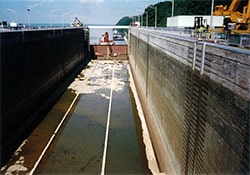Grouting Machinery Base Plates 101
Leave a CommentIn the manufacturing sector, heavy machinery needs to be secured to the concrete below to ensure that it is firmly in place and will provide optimal performance. The mounting process typically involves mounting soleplates/baseplates directly to the concrete below. The grouting of machine baseplates and bearing plates, and of anchoring alignment equipment to a foundation are low-cost approaches that provide a high quality machine-to-foundation connection.
Grout is poured between the two plate surfaces (normally steel and concrete) components to provide greater stability, alignment, vibration isolation, and leveling. Base plate grouting operations traditionally utilize cement grout. However, many industries are turning towards epoxy grout due to its rapid strength development and superior material properties.
The following blog outlines the importance of grouting base plates, how to go about the grouting process, and common issues that may arise during the process.
 What Is the Purpose of Grout Under Base Plates?
What Is the Purpose of Grout Under Base Plates?
Grout acts like a liquid shim between two surfaces and is used to secure the base plates of heavy machinery to the foundation which allows the machinery to function properly. Additionally, the grout reduces operational vibrations that can cause structural damage, machinery malfunctions, and machinery damage.
There are two primary types of grout that are used for this purpose—epoxy grout and cement grout.
What Is Epoxy Grout?
Epoxy grout is made from epoxy resins and an aggregate. This mixture gives the substance its excellent durability, hardness, and water-resistant properties. The rapid strength development, bond strength and chemical resistance supplied by epoxy resin and filler material makes it ideal for situations where vibrations, water, chemicals, and heat are regularly present. ANSI (ANSI A118.3) qualification is an important hallmark of great quality to look out for when evaluating epoxy grout options.
What Is Cement Grout?
Cement grout is made with water, cement, and sand. Cement grout comes in a variety of forms (e.g., high-abrasion, fast-setting, etc.) and is used in a range of industrial applications.
Epoxy Grout vs. Cement Grout
While cement grouts are implemented throughout a wide range of industries, they make a poor choice for machinery grout for a number of reasons. For example:
- Cement grout is not designed to resist continuous impact loading and the vibrations of heavy machinery. When exposed to these stresses, the material cracks or otherwise experiences damage, which can have severe ramifications for both the machine and the concrete beneath it. Epoxy grout, on the other hand, has incredible bond strength and natural resistance to vibration.
- Cement grout can shrink between the base plate and sole plate. If this happens, the grout may crack, threatening the stability of the bond between the two plates. Epoxy grout has low inherent shrinkage, reducing this risk.
- Cement grouts are also vulnerable to chemical attack which can degrade the grout over time. Epoxy grouts are both water- and chemical-resistant, making them ideal for heavy machinery, especially in facilities exposed to chemicals or wet processing.
What Is the Machine Base Plate Grouting Procedure?
Properly grouting a sole plate involves the following steps:
- Preparing the surface of the concrete and the sole plates. Before installation of the grout, the surface of the concrete and the plate must be adequately prepared. The surfaces of all components should be free of dust, dirt, and debris that may affect the quality of the grout bond. For the plate, any primers or coatings should also be removed prior to installation.
- Pouring the grout. To pour epoxy grout successfully, optimal viscosity, flow rate, and grout temperature conditions must be met—each of these aspects can be advised and verified by the grout manufacturer. A leakproof form should be built to surround the base plate. Using a grout headbox to facilitate the flow of the grout into the form.
- Finishing the edges of the base plate. Cement grouts require finishes that are flush to the edge of the plate and chamfered at a slope, while epoxy grouts can be tapered off beyond the edge of the plate.
During base plate grouting operations, some of the most common problems that arise include:
- Incorrect grout usage. Make sure you are using the appropriate grout for your unique situation. If you’re using heavy machinery that generates vibrations, you may want to use epoxy grout.
- Voids in the grout. Always fully mix the grout (i.e., mix the liquids together before adding the aggregate) and ensure that the base plate is level, the headbox is correct size to allow the grout flow correctly.
- Formation of cracks in the grout. If you’re using cement grout, you must manage the grout expansion under the base plate. If you’re using epoxy grout, you don’t have to worry about this issue due to its low inherent shrinkage provided the depth of pour is considered.
Contact Copps Industries for Your Epoxy Grout Needs
When mounting machinery—especially any type that generates or must endure significant vibrations—to base plates, epoxy grouts are the ideal solution. At Copps Industries, we provide a variety of epoxy grout solutions, including:
 K-005 Quick Fill
K-005 Quick Fill- K-009 High Performance
- K-011 Acid Resistant
- K-840 Non-Corrosive Deep Pour
- And many more – check out our full machinery installation grouts page for details
For more information on epoxy grouts or our product offerings, contact us today. If you’re ready to get started with an epoxy grout and would like to reach out to the Copps Industries team, please request a quote.





